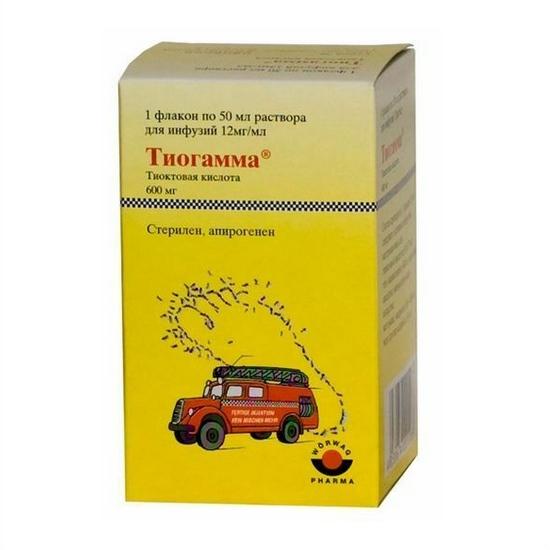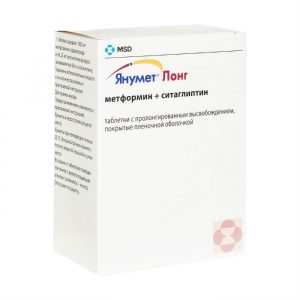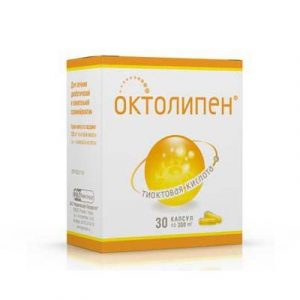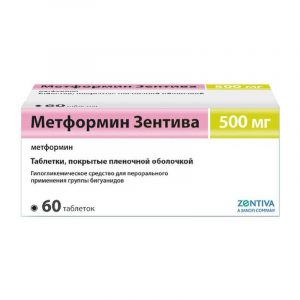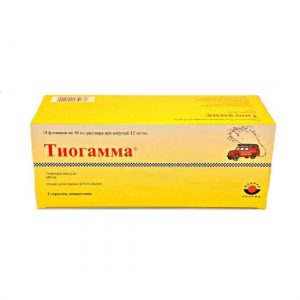Description
Release form
Solution for infusion
Packing
1 bottle of 50 ml.
Pharmacological action
Thiogamma has hepatoprotective, hypoglycemic, detoxification, hypolipidemic, hypocholesterolemic effect.
Thioctic acid (alpha-lipoic acid) – an endogenous antioxidant (binds free radicals), is formed in the body during the oxidative decarboxylation of alpha-ketoxylate.
As a coenzyme of mitochondrial multienzyme complexes, it participates in the oxidative decarboxylation of pyruvic acid and alpha-keto acids.
Helps reduce blood glucose and increase glycogen in the liver, as well as overcome insulin resistance. By the nature of the biochemical action, it is close to B vitamins. Participates in the regulation of lipid and carbohydrate metabolism, stimulates cholesterol metabolism, and improves liver function.
Has hepatoprotective, hypolipidemic, hypocholesterolemic, hypoglycemic effect. Improves trophic neurons. The use of the meglumine salt of thioctic acid in solutions for intravenous administration (having a neutral reaction) can reduce the severity of adverse reactions.
Pharmacokinetics
When taken orally, it is rapidly and completely absorbed from the gastrointestinal tract (ingestion reduces absorption). The time to reach maximum concentration is 40-60 minutes. Bioavailability is 30%.
Has the effect of first passing through the liver. The formation of metabolites occurs as a result of side chain oxidation and conjugation.
Distribution volume – about 450 ml / kg. Thioctic acid and its metabolites are excreted by the kidneys (80-90%). The elimination half-life is 20-50 minutes. The total plasma clearance is 10-15 ml / min.
With intravenous administration, the time to reach the maximum concentration is 10-11 minutes, the maximum concentration is 25-38 mcg / ml. The area under the concentration-time curve is about 5 μg h / ml.
Indications
Diabetic polyneuropathy, alcoholic polyneuropathy.
Contraindications
– Hypersensitivity to the components of the drug
– Pregnancy
– period of breastfeeding.
Clinical data on the use of Thiogamma in children are not available, therefore, children should not be prescribed the drug.
Use during pregnancy and lactation
The drug should be used only under the condition of regular medical supervision.
Monotherapy of epilepsy begins with the administration of the drug in low doses, gradually increasing them to achieve the desired therapeutic effect.
In some cases, treatment with antiepileptic drugs was accompanied by the occurrence of suicidal attempts / suicidal intentions. This was also confirmed by a meta-analysis of randomized clinical trials using antiepileptic drugs. Since the mechanism of the occurrence of suicidal attempts when using antiepileptic drugs is not known, their occurrence cannot be ruled out during treatment with Finlepsin ® retard. used to treat alcohol withdrawal.
When transferring a patient to carbamazepine, the dose of the previously prescribed antiepileptic drug should be gradually reduced until it is completely canceled. Sudden discontinuation of carbamazepine can trigger epileptic seizures. If it is necessary to abruptly interrupt treatment, the patient should be transferred to another antiepileptic drug under the cover of the drug indicated in such cases (for example, diazepam iv or rectally, or phenytoin iv).
Several cases of vomiting, diarrhea and / or decreased nutrition, convulsions and / or respiratory depression in newborns whose mothers were taking carbamazepine at the same time as other anticonvulsants have been described (perhaps these reactions are manifestations of withdrawal syndrome in newborns).
Keep in mind
Patients with severe diseases of the cardiovascular system, liver and kidney damage, as well as the elderly, the drug is prescribed in lower doses.
Although the relationship between the dose of carbamazepine, its concentration, and clinical efficacy or tolerance is very small, regular determination of the concentration of carbamazepine in plasma is also useful when there is a sharp increase in the frequency of seizures to check the regularity of patient administration during pregnancy in treating children or adolescents with suspected violations absorption of the drug in cases of suspected development of toxic reactions if the patient is taking several drugs.
Against the background of the use of the drug, it is recommended to stop drinking alcohol. If necessary, use the drug during lactation should stop breastfeeding.
In experimental animal studies, no teratogenic effect of thioctic acid was detected. No similar human studies have been conducted.
There is no data on the excretion of thioctic acid with breast milk.
Special instructions
Patients taking Thiogamma should refrain from drinking alcohol.
During the treatment with Tiogamma, especially at the beginning of therapy, it is necessary to monitor blood glucose levels. In some cases, dose adjustment of hypoglycemic drugs may be required.
Composition
1 bottle of 50 ml of solution for infusion contains:
active substance:
meglumine salt of thioctic acid – 1167.7 mg (equivalent to 600 mg of thioctic acid)
excipients:
meglumine, macrogol 300,
water.
Dosage and administration
The drug is also administered intravenously at a dose of 600 mg per day (1 ampoule of concentrate for preparing a solution for infusion of 30 mg / ml or 1 bottle of solution for infusion of 12 mg / ml).
At the beginning of the course, the drug is administered intravenously for 2-4 weeks. Then you can continue taking the drug inside at a dose of 300-600 mg per day.
The drug should be administered slowly, eat in no more than 50 mg of thioctic acid in 1 minute (which is equivalent to 1.7 ml of concentrate for the preparation of a solution for infusion of 30 mg / ml).
Side effects of
From the side of the central nervous system: rarely (after iv administration of the drug) – convulsions, diplopia with rapid administration – increased intracranial pressure.
From the blood coagulation system: after iv administration of the drug – hemorrhagic rash, thrombophlebitis, pinpoint hemorrhages in the mucous membranes and skin.
Allergic reactions: urticaria, systemic reactions (up to anaphylactic shock).
Other: hypoglycemia may develop (due to improved glucose uptake) after rapid iv administration – difficulty breathing (passes on its own).
Drug Interactions
When used together, Thiogamma as a solution for injection reduces the effectiveness of cisplatin.
With the simultaneous use of Thiogamma enhances the action of insulin and oral hypoglycemic agents.
When taken with ethanol, the therapeutic effectiveness of thioctic acid may be reduced.
Pharmaceutical interaction
In vitro thioctic acid reacts with complex metal ions (e.g. cisplatin), and also forms moderately soluble complex compounds with sugar molecules. Therefore, the infusion solution is incompatible with glucose solution, Ringer’s solution and with solutions that can react with SH-groups or disulfide bridges.
Overdose
Symptoms: nausea, vomiting, headache.
Treatment: carry out symptomatic therapy. There is no specific antidote.
Storage Conditions
Store in a dark place at a temperature of 15 ° to 25 ° C.
active substance
thioctic acid
Terms leave through pharmacies
More prescription
lekarstvennaja form
Solution for infusion
Solufarm Pharmaceuticals Erzoygniss GmbH, Germany
